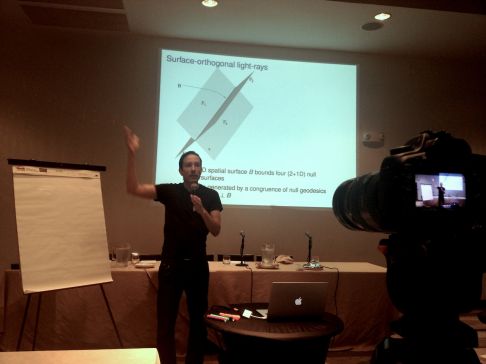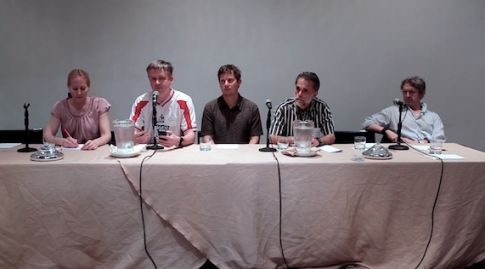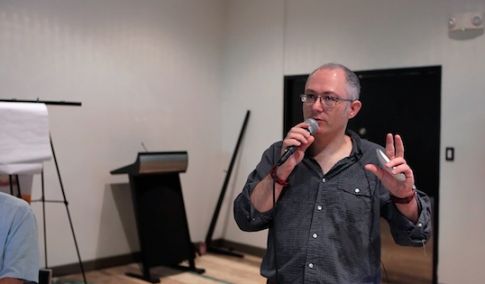
Raphael Bousso vs the World
The final full day of the conference in Vieques began with a session on quantum gravity. (Some slides and videos from the meeting are now up: here.) Seth Lloyd led off the longer talks by essentially summarizing what we know about in-falling information in black holes and gave the sage advice that if you should find yourself falling into a black hole, whatever you do, don't struggle. (Some background on the firewall issue and whether you catch fire when you fall into a black hole: here.) He was followed by Raphael Bousso who essentially argued that we can't get rid of firewalls but we also can't prove it. I will have more to say on this in a moment.
After Bousso came Carlo Rovelli who gave a fascinating talk on thermodynamics in gravitational fields. He began by introducing the Tolman-Ehrenfest effect that argues that temperature is actually not constant in space at thermal equilibrium but, rather, varies with gravitational field. In particular it is dependent on the local metric equation. This is in contrast to the so-called Zeroth Law of Thermodynamics which, somewhat trivially, says that if two systems are in equilibrium with a third, then all three are in equilibrium which implies that the temperature must be a constant. Rovelli, on the other hand, argued that if we re-interpret the Zeroth Law, it can be preserved if we assume that information remains constant. That is, though the temperature may not remain constant since it is technically a dynamical property (at least by certain definitions), the information adjacent systems have about one another remains constant instead. Incidentally, the definition Rovelli used was that temperature is a measure of the number of states transiting a boundary per unit time. This is part of a larger argument that Rovelli makes that quantum gravity (due to effects such as this) demands that we work without space and time. Personally, I think he has a valid point, though it is difficult to do (nevertheless, generalized probabilistic and information-based theories offer some promise).
There were a few short talks prior to the panel discussion having to do with firewalls and black hole complementarity and then the sparks began to fly. In my summary talk I referred to it as "Raphael Bousso versus the world" which is a bit of an oversimplification, but the rest of the panel seemed to put Raphael's feet to the fire. (Zeeya's note: Ian's summary talk slides are available here. Nice title, Ian!) Seth Lloyd and Don Page did eventually come to his defense, but it was quite the spirited debate. While I am not an expert on the subject, I noticed another bifurcation of sorts along the GR/quantum lines. To emphasize how spirited a discussion this session became, Anthony Aguirre tried to simply obtain some consensus on the source of Hawking radiation and it was like pulling teeth. After much prodding and more spirited discussion, Andrew Hamilton had the last word by answering that whatever it is, it's physical and dictated by nature which says to me that there's a lot more work to do.

Existential Risk: What\'s going to kill us first? What will hurt the most?
After lunch there was another session of lightning talks. I actually made it to these so I can briefly summarize (especially given that they may not have been videotaped, though I'm not sure). First up was Bill Poirier who gave a quick talk about single-particle, relativistic Bohmian mechanics. Hendrick Ulbricht followed with a quick introduction to the MAQRO project which aims to investigate macroscopic quantum states. Jeff Tollaksen followed with a talk about time-symmetric quantum mechanics and weak values (basically an overview of his usual work). David Craig then discussed decoherent histories and the relational interpretation of quantum mechanics (he also discussed the Cauchy-Schwarz inequality and the uncertainty relation which is a very interesting topic, but is worth a blog post unto itself). Mauro D'Ariano then talked about a derivation of the Dirac equation from purely information-theoretic principles, in particular quantum cellular automata. Howard Barnum discussed generalized probabilistic theories, in particular discussing dual spaces which are actually a fascinating topic that gets into rigged Hilbert spaces and other such intriguing things (also fodder for another blog post). Ken Wharton then argued that we should be spending more time looking at path integrals (he's winning me over to some of his arguments). Markus Mueller then discussed the relationship between geometry and probabilities as it pertained to information. Laurence Doyle of SETI talked about how non-human forms of communication (e.g. in other animals and even plants) can help to inform SETI via information theory (notably Zipf's law). Craig Hogan then spoke about on-going experiments in Planck-scale physics at Fermilab in which he discusses the fact that spacetime geometry itself was wiggling (this is an idea first proposed by Eddington in his Fundamental Theory). Steve Gratton then discussed the interplay of maximum entropy methods and quantum field theory. Finally Michael Vassar introduced a company that he co-founded with Jaan Tallinn and others called MetaMed Research that is focused on delivering information on medical issues and noted that they were hiring.
The final session of the day focused on two, somewhat related topics. The first topic was set up by the announcement of the next FQXi essay contest which focuses on how humanity can steer our future. The contest is co-sponsored by the aforementioned Jaan Tallinn who, these days, focuses a lot of his energy on addressing existential risk (he has even helped start a center to study the topic at Cambridge). The first session then began with a poll of the panelists and then the audience concerning what they viewed as the greatest existential risk that humanity presently faces. The answers were generally what you would expect--global warming, AI gone bad (this has long been Jaan's bugbear), biotechnology, loss of biodiversity, rogue comets, unfettered greed--but it took awhile before anyone really brought up education (or lack thereof) as really being at the root of every single one of these problems. I piped up and said that none of these problems can be successfully tackled if people don't understand and/or simply don't care. In other words, humanity is really the greatest existential risk to itself. Unfortunately (in my personal opinion) not enough time was spent discussing this given that it is at the root of all of these problems. How can we change attitudes and better educate people? One thing we can't do (that I tried to emphasize both after this session as well as after my summary talk the next morning) is dismiss other people's concerns as trivial or not relevant. Whether we agree with it or not, people who have, for example, economic reasons for doubting global warming, are not going to change their minds simply because we tell them to. To them, their concerns are very real and we need to at least recognize that even if we do not agree. Otherwise they will simply ignore us or worse, work to undermine us.

Ian Durham wrap things up
An argument that I found particularly interesting--and one that I happen to agree with--was put forward by Everard Findlay who said that scientists and artists are the ones who can really save the world and they have to find ways to work together. Similarly, Sarah Hreha argued for more integration between science and society founded on empathy (something I had pointed out more than once). Given that one of the things that art is very good at is inducing emotion which can help foster empathy, I think some of her ideas meshed well with Everard's. And echoing what I had ranted about before, Federico Faggin said we all need to change ourselves.
The second half of the panel focused on the related topic of communicating science and how FQXi can be better at what it does. In a fascinating story that I had not known, Valerie Jamieson noted that the wireless protocol 802.11 that we all use probably every day came out of fundamental astronomical research by John O'Sullivan. Emphasizing some of the issues mentioned above, Jennifer Ouellette noted that science journalism is a two-way street--we can't simply lecture at our audience.
There was some interesting discussion on the final morning of the conference after my summary talk, but much of it built on discussions already mentioned in previous posts. All-in-all, it was an excellent conference, as usual. One of the best things about these conferences is the ability to make connections and start (or continue) collaborations. In a conversation with Kevin Knuth, he openly wondered how much we might accomplish if we stuck a bunch of people like this in the same place for a month. I think I could handle a month on Vieques. Maybe.